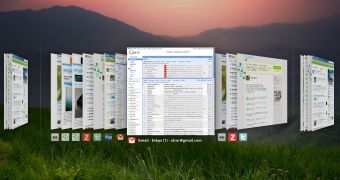The most anticipated announcement of the Chrome event Google held earlier was, without a doubt, Chrome OS. Google's ambitious operating system is seeing the light of day but, unfortunately, it's not quite complete yet and you won't be able to buy a Chrome OS-powered netbook for at least six more months.
"Chrome OS is at the stage where we need feedback from real users. Some of the features of Chrome OS require new hardware, but we didn’t want to sell pre-beta computers," Linus Upson, VP Engineering and Sundar Pichai, VP Product Management announced.
"Instead we’re launching a pilot program where we will give test notebooks to qualified users, developers, schools and businesses. We're starting with the U.S. and will expand to other countries once we get the necessary certifications," they added.
It is somewhat of a letdown that Chrome OS didn't get a full-blown launch ahead of the holiday season, as Google initially intended. But you can still get your hands on Chrome OS and, more importantly on a Chrome OS netbook, provided you live in the US and are lucky enough to get picked by Google.
As far as the operating system goes, Google didn't really showcase that many new features. The discussion centered on what Chrome OS aims to achieve and the big features, but the demo didn't get into too many details.
On the other hand, Chrome OS is essentially the Chrome browser with some functionality tacked on so there aren't that many things about it that are particularly new or surprising.
Google Chrome OS is lightning fast
The same main goals Google has for Chrome are true for Chrome OS as well. Google Chrome OS is fast. Google touts a 10 second initial boot time, instant resume from standby and an initial set up of under 60 seconds.
The first time you power up a Chrome OS netbook you'll be greeted by a short setup wizard. You have to choose things like location and language and select the network connection you want to use.
After you agree to the Chrome OS terms, updates, if any, are downloaded and installed. All you have to do then is log in with your Google account, though you can skip this step, and take your picture with the built in webcam, also optional.
All of this shouldn't take more than one minute after which you'll be greeted with the browser along with all of your existing Chrome apps and customizations.
After this initial setup, it shouldn't take more than 10 seconds form pressing the power button until you're in your browser. Waking up is even faster, essentially instant.
If the netbook is in standby, by the time you've opened the lid all the way, the browser should already be loaded.
Chrome OS will be secure from the firmware to the browser
Another big advantage of Chrome OS is security. The operating system has been built from the ground up with security in mind, starting from the firmware all the way to the browser.
Google listed some of the things that help protect users in Chrome OS. One obvious thing is the fact that it's running Chrome, already one of the most secure browsers out there.
Chrome's sandboxing technology has been taken one step further and the browser itself is sandboxed, at the OS level. Also like the browser, Chrome OS will be automatically updated so you'll always be running the latest and most secure version, eliminating another risk factor.
Where it gets really interesting is with user data. Chrome OS doesn't have local storage in the traditional sense. While data will be available locally, even when offline, everything lives in the cloud and is only cached on the machine.
All this data though is encrypted so, even if it is physically there, it would be impossible for attackers to access it without your account credentials.
But it goes deeper, all Chrome OS machines will have the core part of the operating system, which initializes the OS, in read-only mode so it will be impossible to alter. This code is the first to run when you're powering up and checks to see if everything else is in order and if anything has been modified, there is a backup copy online.
Of course, most of these details had been known since Google unveiled Chrome OS a year ago. This is because many of the finer details are still not done yet. For example, things like USB hardware support are still in the works. This is the reason why most of us will have to wait until next year to see Chrome OS in action.

 14 DAY TRIAL //
14 DAY TRIAL //